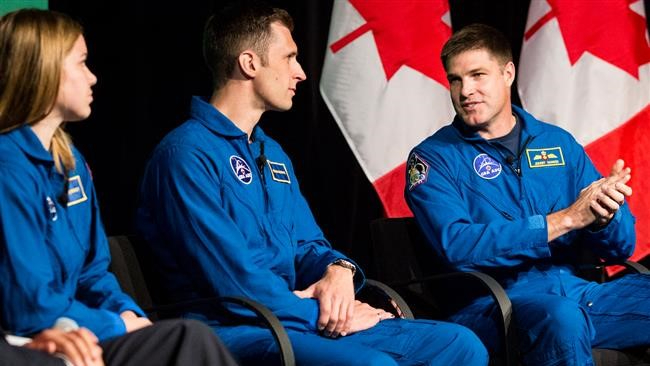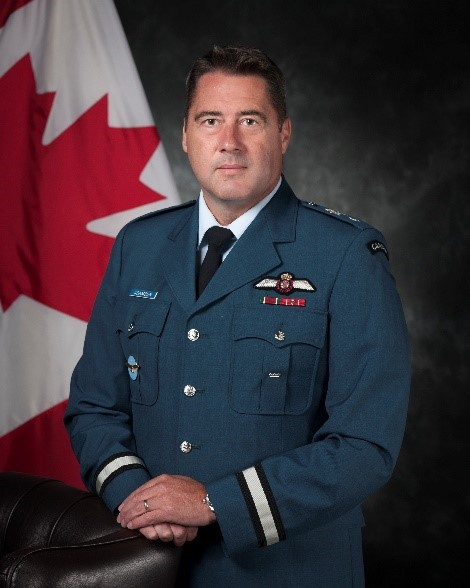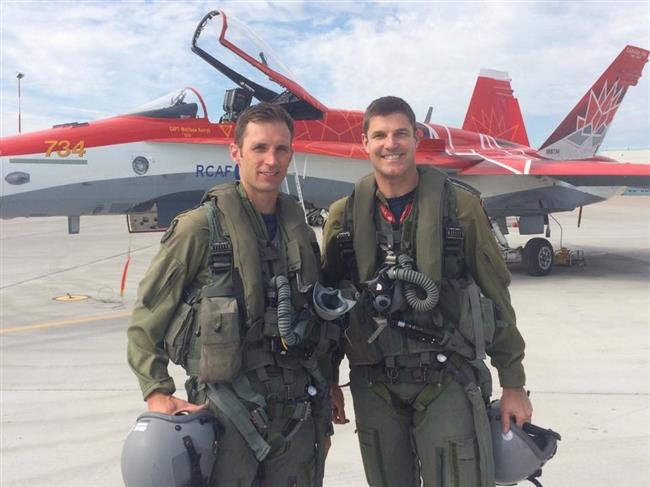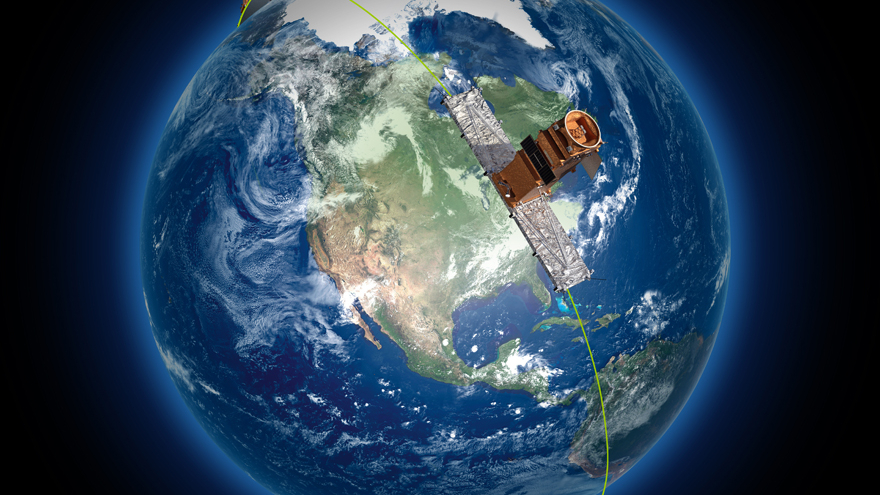Canada's 'Space Force' soars with new astronaut assignments

Canada's next two astronauts in space will shine a light on the country's fast-growing military space activities, says its top military space official.
Canadian Space Agency (CSA) astronauts Jeremy Hansen and Josh Kutryk are both colonels and pilots with the Royal Canadian Air Force. This year they were assigned to the Artemis 2 moon mission in 2024 and the International Space Station (ISS) in 2025, respectively. (Civilian CSA astronaut Jenni Gibbons will back up Hansen on Artemis 2; her assignment was also announced this year.)
Similar to the U.S. military's consolidation of space-focused activities into one unified Space Force, Canada recently centralized its space activities into its own space division — and there are no lack of projects to work on, between renewing old satellites, conducting joint exercises with the United States and staying abreast of new technologies.
The 3 Canadian Space Division (3 CSD) commander, Brigadier-General G. Michael Adamson, recently spoke with Space.com via email from Germany about what's next for Canada's military space activities, and the excitement surrounding the new CSA astronaut assignments.
Related: Canada assigns astronauts to launch on Boeing's Starliner, back up Artemis 2 moon mission
Canada expects to fly two RCAF astronauts in a row (Hansen and Kutryk) in 2024 and 2025, respectively. What will that opportunity do in terms of raising awareness for your community, or in allowing you to do more space projects?
Brigadier-General G. Michael Adamson: Obviously, this is a very exciting time, with two of our members getting ready to fly to space. Both Jeremy and Josh are incredible ambassadors of the RCAF, and we're extremely proud of their success. Space has a way of capturing the imagination of the public, and as Jeremy orbits the moon and Josh experiences his time on the ISS, a whole new generation of Canadians will be inspired to reach for new heights themselves. Perhaps some of those individuals will find their path leads to us at 3 CSD. The space domain is only growing more dynamic and exciting, and the sky really is the limit.
How similar is 3 CSD to the United States Space Force?
Adamson: The establishment of 3 CSD represented the operationalization of the space domain within the Canadian Armed Forces (CAF), and is in line with what our allies have done — including, of course, the United States. But it's perhaps more similar in size and structure to the space commands of the United Kingdom and Australia.
3 CSD has streamlined how we meet our mandate: supporting CAF operations with space effects, space domain awareness, and defending and protecting military space capabilities. While our daily business hasn't changed, how we fit into the broader CAF organization has transformed. As a result, space is better integrated into operational planning and execution of CAF operations. We're slowly but surely been building "spacemindedness" within the CAF: That is, the mindset that acknowledges the critical dependency that every CAF operation and activity has on space.
What is your role as Commander of 3 CSD?
Adamson: I wear two hats. As commander, I am responsible for the administrative functions of the division such as strategic engagements, and the generation and development of personnel. 3 CSD includes the Advanced Space Effects Flight, which works with national and international space allies and partners to identify space capability gaps, as well as disruptive innovation opportunities and risks.
The other hat I wear is as the Joint Space Force Component Commander, where I'm responsible for the delivery and use of space capabilities to support operations. The operational business is conducted by 7 Wing (Space), which is responsible for Space Force Employment. We work closely with the Royal Canadian Air Force (RCAF) headquarters to identify and establish projects that will advance the CAF's space capabilities.
Related: Canadian radar satellites to help Ukraine fight off Russian invasion
3 CSD was established only 18 months ago, in July 2022. How are you doing in meeting your goals?
Adamson: We've made a lot of gains since then. There is widespread acknowledgement that space, more than any other domain, demands a collective approach. This "allied by design" approach provides an advantage that our competitors cannot match, and it governs 3 CSD's work with its closest allies.
The Canadian Joint Operations Command (CJOC) issued the first named operation specific to space, Operation Stratus, which aims to integrate space capabilities into all CAF operations. This operation was developed in close coordination with 7 Wing (Space) and 3 CSD.
Also, these partnerships were formalized in various Memorandums of Understanding (MOU) signed over the past year and a half:
- The CAF and the Canadian Space Agency (CSA) renewed a long-standing MOU Concerning Cooperation in Space Related Activities, first signed in 2001. This agreement identifies new objectives, and strengthens areas of collaboration from the first version.
- The RCAF and United States Space Command signed an MOU concerning enhanced space cooperation for deepened military cooperation in the space domain between the two nations' militaries.
- The CAF and the U.S. National Reconnaissance Office renewed an MOU for Defense Space Cooperation and Capability Development to enhance space intelligence, surveillance, and reconnaissance cooperation and capability development.
Related: US Space Force creates 1st unit dedicated to targeting adversary satellites
Breaking space news, the latest updates on rocket launches, skywatching events and more!
What are the priority items for Canada in military space?
Adamson: Providing space capabilities to support Canada's security objectives is a top priority, and we have several future projects under way to that end. We're focused on three major areas: Surveillance of space, surveillance from space and satellite communications in our Arctic region.
First, is the replacement of the Sapphire reconnaissance satellite. It contributes to the process of identifying and tracking artificial objects in space, including space debris, that could threaten Canadian and allied space-based systems. The Surveillance of Space 2 project will provide surveillance of space data through a space-based sensor, and will also be adding a ground-based sensor system which will improve the versatility and resilience of the overall capability. Like our allies, and adversaries, we also recognize the growing importance of cislunar space operations, for both human exploration and defense purposes. Our future SDA capabilities will address that requirement.
Second is the follow-on funding to the Radarsat Constellation Mission (RCM), which is managed by the CSA using satellites from MDA. We use RCM's synthetic aperture radar data, combined with Automatic Identification System on board the satellites, to monitor routine traffic in and through Canadian territory and improve our situational awareness within the maritime domain. While we are working on a replacement project that can provide this capability as well as some additional CAF-specific capability, it's currently in the early stages of analysis.
Finally, we're investigating satellite communications (satcom) requirements we need to "plus up" to be effective in the north. While we have currently partnered with the U.S. and other allies to provide satcom, we are looking at additional options to expand this capability.
Related: Canada to launch new satellites to monitor climate change, gather military data
What space activities has the CAF done recently with the United States, and other allies?
Adamson: 3 CSD participated in several U.S.-led international space exercises and wargames. These activities are designed to explore critical space issues and means to address them, while highlighting areas of interoperability and opportunities to deepen international relationships. Examples include the 25th iteration of Schriever Wargame, Thor's Hammer, the Global Integrated Wargame, as well as Exercises Space Flag and Global Sentinel.
7 Wing (Space) has also been busy. Over the past year and a half, they've focused on building the organization, updating and formalizing space training for CAF members, continuing to evolve the Space Domain Awareness (SDA) capability, and growing other space control areas such as space electronic warfare. The Wing has recently started holding shifts as part of the U.S. Space Command's Joint Task Force Space Defence Commercial Operations Cell (JCO). JCO operators access worldwide commercial sensor data, they gather, analyze, and share this information with partner nations to increase SDA.
Also on the SDA front, 7 Operations Support Squadron made significant strides. They developed a nascent DevOps (development operations) capability, which has already garnered interest from allied and partner nations. From a space electronic warfare perspective, the squadron established the Canadian Space Aggressor Team (CSAT), which can integrate into CAF exercises with space-based assets. This past summer, the squadron participated in the Canadian Army's largest training event, Exercise Maple Resolve, and conducted GPS jamming against both Canadian Army and RCAF assets. This created a degraded environment, which participants had to adapt their standard procedures and training to overcome.
Related: Space is 'more contested' than ever by world's militaries, US Space Force chief says

In 2022, G. Michael Adamson became the first Commander of 3 Canadian Space Division (3 CSD) when his role transitioned from being Royal Canadian Air Force (RCAF) Director General Space. Adamson joined the Canadian Air Force in 1993 and has held numerous senior leadership roles, including postings in the Arabian Gulf and Indian Ocean.
François-Philippe Champagne, the Canadian cabinet minister responsible for the CSA, said in November that CAF members can seek their "pathway to the stars" through space. What examples can you provide for Canadian military personnel that are not astronauts?
Adamson: Certainly, there's a career in space for those military members not aspiring to be an astronaut. Since there is no space-specific trade within the CAF, 3 CSD is really looking for motivated personnel from any occupation and any service who are excited about the space domain. We train them in-house and employ them in space operations.
With the announcement of Jeremy joining the Artemis 2 crew, we realized we needed a 3 CSD position nested within NASA to provide operational support to the Canadian astronaut corps. We established the Canadian Astronaut Coordination Officer position at the NASA Johnson Space Center in Houston, and placed Capt. Erin Edwards there this summer.
She was serving as a Special Forces aviator and operations officer at 427 Special Operations Aviation Squadron in her last posting. She is currently training with the Flight Operations Directorate to assume the capcom (capsule communicator) flight controller position. In this position, she will serve as the critical voice link between NASA Mission Control in Houston, and astronauts on board the International Space Station.
If that wasn't enough, Erin was just named as NASA's deputy branch chief for crew operations, also known as the ops officer. It's the first time this position has ever been held by someone who is not an astronaut. In this role, she'll be responsible for the operations cell, including a small staff of schedulers and planners. They will ensure astronauts are meeting training, currency, and other requirements for those astronauts not assigned to a mission, and manage roughly 60 astronauts in total. So clearly, she's representing 3 CSD and the RCAF exceptionally well, and we're extremely proud of her success.
This interview has been edited for length and clarity.

Elizabeth Howell (she/her), Ph.D., was a staff writer in the spaceflight channel between 2022 and 2024 specializing in Canadian space news. She was contributing writer for Space.com for 10 years from 2012 to 2024. Elizabeth's reporting includes multiple exclusives with the White House, leading world coverage about a lost-and-found space tomato on the International Space Station, witnessing five human spaceflight launches on two continents, flying parabolic, working inside a spacesuit, and participating in a simulated Mars mission. Her latest book, "Why Am I Taller?" (ECW Press, 2022) is co-written with astronaut Dave Williams.


